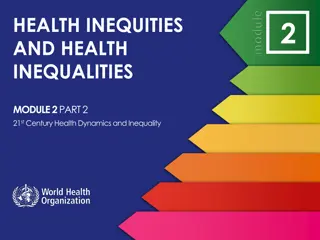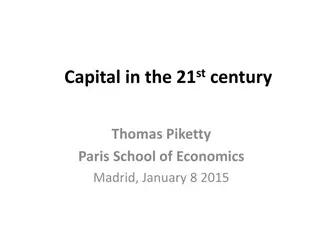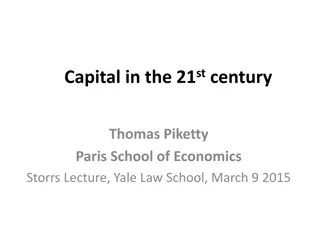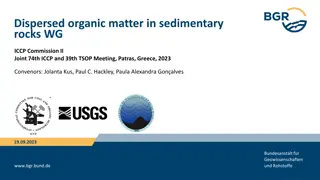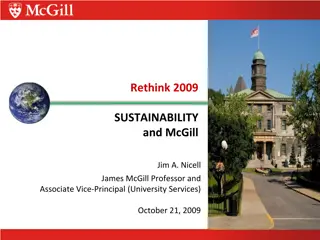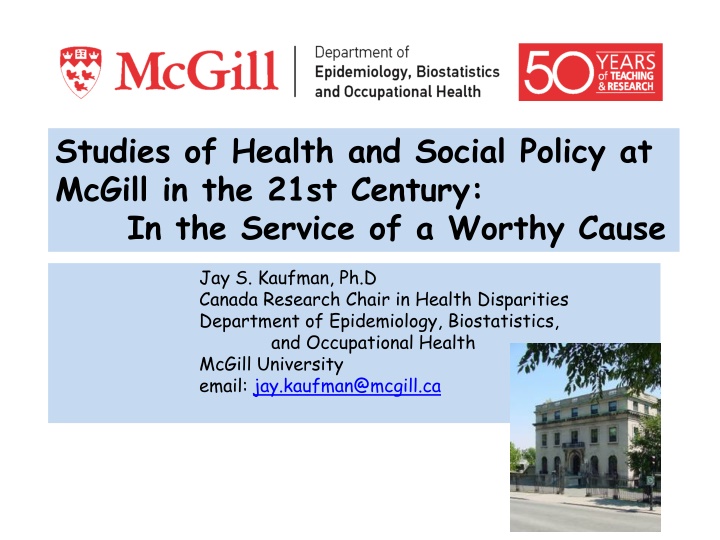
Studies of Health and Social Policy at McGill in the 21st Century
Studies of Health and Social Policy at McGill University address key issues such as social determinants of health, causality in epidemiology, and developing evidence-based policies. Researchers aim to inform health-related social policies with a focus on disparities and population health.
Download Presentation

Please find below an Image/Link to download the presentation.
The content on the website is provided AS IS for your information and personal use only. It may not be sold, licensed, or shared on other websites without obtaining consent from the author. If you encounter any issues during the download, it is possible that the publisher has removed the file from their server.
You are allowed to download the files provided on this website for personal or commercial use, subject to the condition that they are used lawfully. All files are the property of their respective owners.
The content on the website is provided AS IS for your information and personal use only. It may not be sold, licensed, or shared on other websites without obtaining consent from the author.
E N D
Presentation Transcript
Studies of Health and Social Policy at McGill in the 21st Century: In the Service of a Worthy Cause Jay S. Kaufman, Ph.D Canada Research Chair in Health Disparities Department of Epidemiology, Biostatistics, and Occupational Health McGill University email: jay.kaufman@mcgill.ca
Social Determinants of Health: Central Issues/Problems: social theory and epidemiologic theory (causal inference) etiology vs description (surveillance) modeling and adjustment generalizability population inference development of evidenced-based policies
You observe: You want to know: Pr(Y|X=x) Pr(Y|SET[X=x]) The adjustment tradition in epidemiology and social sciences exists to link these quantities: Z Pr(Y|X=x) Pr(Y|SET[X=x]) X Y BUT! Pr(Y|X=x, Z=z)Pr(Z=z) = Pr(Y|SET[X=x])
Consider two different bivariate associations: 1) Relation between ecologic levels of TV viewing and ecologic rates of dental caries, by country: = expected change in outcome per unit change in exposure Frequency Measure of Dental Caries Hours of Television Viewing per capita
Consider two different bivariate associations: 2) Relation between ecologic levels of refined sugar consumption and ecologic rates of dental caries, by country: = expected change in outcome per unit change in exposure Frequency Measure of Dental Caries Daily Grams of Refined Sugar Consumed per capita Adjust for level of socioeconomic development, and find that Pr(Y|SET[X=x]) is null in scenario #1, and non-null in scenario #2
Many researchers at many universities around the world study social determinants of health with an aim of informing health-related social policy Nieto FJ, IJE 2009 But McGill EBOH is SPECIAL .
We understand that association is not causation and that correlations are not a basis for sound policy: Kaufman JS, Harper S. Health equity: utopian and scientific. Prev Med. 2013 Dec;57(6):739-40. PMID: 24075815 and so we seek study designs that can identify causal effects, which then have direct policy implications: Harper S, Strumpf EC. Social epidemiology: questionable answers and answerable questions. Epidemiology. 2012 Nov;23(6):795-8. PMID: 23038109 Naimi AI, Kaufman JS. Counterfactual Theory in Social Epidemiology: Reconciling Analysis and Action for the Social Determinants of Health. Current Epidemiology Reports 2015; 2(1): 52-60.
We recognize that scale of contrast can arbitrarily changes the appearance of inequalities: Harper S, Kaufman JS, King NB. Increased risk of coronary heart disease in female smokers. Lancet. 2012;379(9818):801-2. PMID: 22386028 King NB, Kaufman JS, Harper S. Relative measures alone tell only part of the story. Am J Public Health. 2010 Nov;100(11):2014-5. PMID: 20864691 Harper S, King NB, Meersman SC, Reichman ME, Breen N, Lynch J. Implicit value judgments in the measurement of health inequalities. Milbank Q. 2010 Mar;88(1):4-29. PMID: 20377756 King NB, Harper S, Young ME. Use of relative and absolute effect measures in reporting health inequalities: structured review. BMJ. 2012 Sep 3;345:e5774. PMID: 22945952 Harper S, King NB, Young ME. Impact of selective evidence presentation on judgments of health inequality trends: an experimental study. PLoS One. 2013 May 16;8(5):e63362. PMID: 23696818
We consider the implications of alternate modeling strategies for identifying causal effects: Harper S, Strumpf EC, Kaufman JS. Do medical marijuana laws increase marijuana use? Replication study and extension. Ann Epidemiol. 2012 Mar;22(3):207-12. PMID: 22285867 and we consider the sensitivity of our inferences to unverifiable assumptions of the models: Nandi A, Glymour MM, Subramanian SV. Association among socioeconomic status, health behaviors, and all-cause mortality in the United States. Epidemiology. 2014 Mar;25(2):170-7. PMID: 24487200
We evaluate the effects of social and health policies in real-world settings in Canada: Smith LM, Kaufman JS, Strumpf EC, L vesque LE. Effect of human papillomavirus (HPV) vaccination on clinical indicators of sexual behaviour among adolescent girls. CMAJ. 2015 Feb 3;187(2):E74-81. PMID: 25487660 King NB, Fraser V, Boikos C, Richardson R, Harper S. Determinants of increased opioid-related mortality in the United States and Canada, 1990- 2013: a systematic review. Am J Public Health. 2014 Aug;104(8):e32-42. PMID: 24922138 Ionescu-Ittu R, Glymour MM, Kaufman JS. A difference-in-differences approach to estimate the effect of income-supplementation on food insecurity. Prev Med. 2015 Jan;70:108-16. PMID: 25475685 Hutcheon J, Harper S, Strumpf E, Lee L, Marquette G. Using inter- institutional practice variation to understand the risks and benefits of routine labour induction at 41+0 weeks. BJOG. 2014 Jul 14. [Epub ahead of print] PMID: 25041161
and in the rest of the world: Quamruzzaman A, Mendoza Rodr guez JM, Heymann J, Kaufman JS, Nandi A. Are tuition-free primary education policies associated with lower infant and neonatal mortality in low- and middle-income countries? Soc Sci Med. 2014 Nov;120:153-9. PMID: 25243641 McKinnon B, Harper S, Kaufman JS, Bergevin Y. Removing user fees for facility-based delivery services: a difference-in-differences evaluation from ten sub-Saharan African countries. Health Policy Plan. 2015 May;30(4):432-41. PMID: 24816570 Nazif-Munoz JI, Quesnel-Vall e A, van den Berg A. Did Chile's traffic law reform push police enforcement? Understanding Chile's traffic fatalities and injuries reduction. Inj Prev 2014 Nov 28 [Epub ahead of print] PMID: 25432938 Atabay E, Moreno G, Nandi A, Kranz G, Vincent I, Assi TM, Winfrey EM, Earle A, Raub A, Heymann SJ. Facilitating working mothers' ability to breastfeed: global trends in guaranteeing breastfeeding breaks at work, 1995-2014. J Hum Lact. 2015;31(1):81-8. PMID: 25348674
We distinguish between descriptive work that traces trends and patterns across time, group and place: Harper S, MacLehose RF, Kaufman JS. Trends in the black-white life expectancy gap among US states, 1990-2009. Health Aff 2014; 33(8): 1375- 82. PMID: 25092839 Harper S, Rushani D, Kaufman JS. Trends in the black-white life expectancy gap, 2003-2008. JAMA. 2012;307(21):2257-9. PMID: 22706828 Elani HW, Harper S, Allison PJ, Bedos C, Kaufman JS. Socio-economic inequalities and oral health in Canada and the United States. J Dent Res. 2012 Sep;91(9):865-70. PMID: 22837551 Yang S, Khang YH, Chun H, Harper S, Lynch J. The changing gender differences in life expectancy in Korea 1970-2005. Soc Sci Med. 2012 Oct;75(7):1280-7. PMID: 22739261
from etiologic work that identifies mechanisms and pathways: Nandi A, Charters TJ, Strumpf EC, Heymann J, Harper S. Economic conditions and health behaviours during the 'Great Recession . J Epidemiol Comm Health. 2013;67(12):1038-46. PMID: 23969346 Naimi AI, Moodie EE, Auger N, Kaufman JS. Stochastic mediation contrasts in epidemiologic research: interpregnancy interval and educational disparity in preterm delivery. Am J Epid 2014;180(4):436-45. PMID: 25038216 Naimi AI, Kaufman JS, MacLehose RF. Mediation misgivings: ambiguous clinical and public health interpretations of natural direct and indirect effects. Int J Epidemiol. 2014 Oct;43(5):1656-61. PMID: 24860122 Kaufman JS, Dolman L, Rushani D, Cooper RS. The contribution of genomic research to explaining racial disparities in cardiovascular disease: a systematic review. Am J Epid 2015 Apr 1;181(7):464-72. PMID: 25731887
health policy subject matter areas population data Studies of Health and Social Policy at McGill causal inference social sciences






